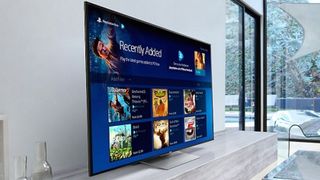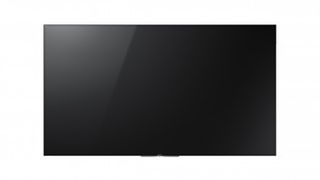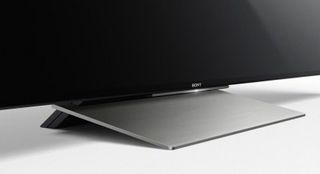Why you can trust TechRadar
History suggests that insanely thin TVs like the 65X930D compromise picture quality. Sony's double light path approach, though, seems on paper at least as if it might be the solution to the sort of contrast issues and 'milky' black colors ultra-thin LCD TVs tend to suffer with.
First impressions of the 65X930D with the AV world's Ultra HD Blu-ray picture quality 'poster boy' are seriously strong. Favorite discs (in picture quality terms) like The Revenant, Kingsman: The Secret Service and Exodus all look absolutely glorious in their 4K and high dynamic range clothes.
This is particularly true where color is concerned. For me, Sony's self-titled Triluminos picture technology has enabled its high-end TVs to maintain an advantage over its TV rivals in color terms for the last two or three TV generations, and the richness and stellar refinement of the 65X930D's color management not only continues this trend but arguably enhances it.
Color dynamics with HDR sources clearly extend far beyond anything you can get from a normal HD, non-HDR Blu-ray or broadcast, instantly making boldly colored scenes like the palace sequences in Exodus: Gods And Kings look sensationally vibrant, three dimensional and realistic.
Where Sony really shows off its color handling skills, though, is in the stunning finesse with which the screen ekes out the very finest color blends and tonal shifts at every tiny point across that expanded color range.
The only word I can come up with that accurately describes the 65X930D's color reproduction is exquisite, and there's no overstating how much of an impact this ability to deliver seemingly infinitely subtle color blends and endlessly natural tones has on picture quality. Everything looks effortlessly cinematic and somehow you're able to both ogle the pictures for picture quality's sake while also being completely immersed in what you're watching.

Expanded brightness and detail
Just as importantly, the 65X930D delivers far more potently on HDR's expanded luminance range than any of Sony's previous edge-lit LCD TVs. Exterior sequences in both The Revenant and especially Exodus look markedly brighter than they do on a non-HDR TV. More importantly you experience a much greater sense of light range between the deepest blacks and brightest whites of the HDR images.
There's nothing showy about the way the 65X930D delivers this greatly expanded contrast/luminance range either. The way it's capable of filling in every subtle light shift between the expanded extremes just means pictures look more realistic and natural. There's no sense of the 65X930D just showing off what it's capable of for the sake of it. It does what it does in the interest of picture quality, not self-promotion.
The twin deftness of the 65X930D's light and color handling with HDR content also helps the screen bring out the eight million pixels of detail the 4K set brings to the picture quality party.
There's no sense of any of the potential detail being lost in inadequate color resolution or light management. On the contrary, 4K's extra resolution has seldom had more of an impact than it does here, building on the spectacular naturalism and beauty the 65X930D's images routinely enjoy.
While the 65X930D's picture quality is often nothing short of stellar, though, HDR's extreme brightness requirements have an all-too predictable trade-off. Namely, the addition of a second light path layer can't prevent some noticeable light pollution problems when showing extreme contrast content like in Chapter 7 of Exodus: Gods And Kings, where Moses meets Nun in a torchlit hut at night.

Backlight blocking
The issue is that when a very bright object appears against a predominantly dark backdrop you can clearly see Sony's new light control system going through its motions in the shape of quite defined rectangles or squares of unwanted light overlaying the darkness around the bright object.
There's undoubtedly an argument to be made that maybe this sort of obvious reminder of the technology being used to deliver HDR's extreme light and dark dynamics is not too heavy a price to pay for all the extra picture quality HDR delivers. It's important to reflect, too, that we've yet to fully test any TV - including OLED ones - that does a flawless job of handling HDR's most extreme light and dark contrasts.
For me, though, the quite defined look to the surplus-to-requirement light around the brightest HDR objects is actually more distracting than the more widespread, but less rigidly defined, light pollution seen with, say, Samsung's new KS9000 TV series.

It's worth adding that the 65X930D's light 'blocking' issues are less obvious if you're watching in a fairly bright room environment. But pictures as cinematic as those the 65X930D produces are just aching for a serious lights-down, Saturday-night-at-the-movies experience, a setting in which the light blocking issues occasionally stand out like an immersion-breaking sore thumb.
One last point to add regarding the 65X930D's HDR performance is that Sony has provided a Vivid HDR picture preset option if you're not finding the default HDR mode aggressive enough.
But while this mode certainly turns HDR up to 11, you lose some of the gorgeous finesse evident in the standard mode, and the light blocking issue becomes pretty much unbearable.
Life in SD
When it comes to standard dynamic range (SDR) playback, the 65X930D is more consistently outstanding versus other standard dynamic range TVs. This is chiefly because the backlight can be driven far less aggressively than it needs to be for HDR, making it much easier to hide the backlight clouding/blocking issues that crop up during dark HDR scenes. You can thus end up with a more consistently immersive experience - especially given that the screen retains its color and clarity finesse with 4K SDR while also still delivering a contrast-rich picture experience.
It struck me while watching non-HDR 4K sources, too, that the 65X930D benefits from some very impressive motion processing that's able to keep much of the impression of 4K clarity and detail levels intact even when there's a lot of movement in the image.
If I have a complaint about the 65X930D's standard dynamic range performance it would be that to remove almost all backlight inconsistencies you have to reduce the set's backlight output more than I would have ideally have liked. Especially as this means the difference between the HDR and SDR images is thus particularly pronounced.

With the video content world still struggling to deliver 4K sources in the sort of quantities 4K TV owners would like, it's still important for 4K TVs to have the processing power to upscale HD to 4K well. And here again the 65X930D scores highly, with its X1 chipset doing a superlative job of calculating all the millions of extra pixels needed to make HD into 4K, without exaggerating or adding noise in the process. Samsung's upscaling system perhaps delivers a slightly greater sense of definition, but Sony's system offers an extra sense of polish and refinement, especially when it comes to color finesse.
The last elements of the 65X930D's picture performance to cover are its 3D and gaming capabilities.
Regarding the former I was a little disappointed. While 3D pictures enjoy strong color and contrast, as well as a decent amount of detail, Sony's usually excellent motion handling loses its way a bit in the 3D realm resulting in signs of judder or blur. Also, sharply contrasting objects in the mid or far distance fairly routinely suffer with slight crosstalk ghosting noise.
When it comes to gaming, I recorded an input lag (the time the screen takes to render images) measurement using the TV's game picture preset of marginally under 50ms. This isn't a horribly bad figure, but at the same time it's about one image frame higher than I really like to see - and surprisingly it's around 25ms higher than the figures I've generally recorded with previous Sony 4K TVs.
Current page: Picture quality
Prev Page Introduction and features Next Page Sound, value and verdictAV Technology Contributor
John has been writing about home entertainment technology for more than two decades - an especially impressive feat considering he still claims to only be 35 years old (yeah, right). In that time he’s reviewed hundreds if not thousands of TVs, projectors and speakers, and spent frankly far too long sitting by himself in a dark room.

The obscure little PC that wanted to be a big NAS — super compact Maiyunda M1 doesn't cost that much, offers up to 40TB SSD storage, runs Windows and has 4 Gigabit Ethernet ports

Image site Abload going offline reminds me of how much online content we've permanently lost

Gemini's next evolution could let you use the AI while you browse the internet

